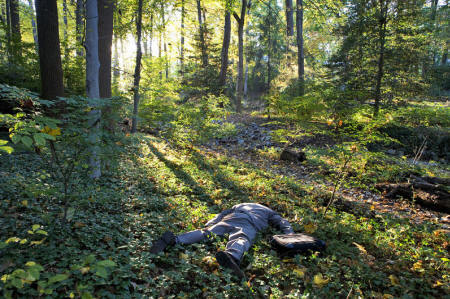|
are still working up to 48 hours after death has implications for organ transplants,
forensics and our very
definition of death
Genes Get Active
After Death
New evidence in animals suggests that
many genes go on working for up to 48 hours after the lights have
gone out. Peter Noble and Alex Pozhitkov at the University of Washington, Seattle, and their colleagues investigated the activity of genes in the organs of mice and zebrafish immediately after death.
They did this by measuring the amount of messenger RNA present. An increase in this mRNA - which genes use to tell cells to make products such as proteins - indicates that genes are more active.
Noble's team measured mRNA levels in zebrafish, and in brain and liver samples from mice at regular intervals for up to four days after death. They then compared these with mRNA levels measured at the time of death.
"Hundreds of genes with different functions woke up after death, including fetal development genes".
As you might expect, overall mRNA levels decreased over time.
However, mRNA associated with 548 zebrafish genes and 515 mouse genes saw one or more peaks of activity after death. This meant there was sufficient energy and cellular function for some genes to be switched on and stay active long after the animal died.
These genes cycled through peaks and dips in activity in a "non-winding down" manner, unlike the chaotic behavior of the rest of the decaying DNA, says Noble.
Hundreds of genes with different functions "woke up" immediately after death. These included fetal development genes that usually turn off after birth, as well as genes that have previously been associated with cancer.
Their activity peaked about 24 hours after death.
A similar process might occur in humans.
Previous studies have shown that various genes, including those involved in contracting heart muscle and wound healing, were active more than 12 hours after death in humans who had died from multiple trauma, heart attack or suffocation (Forensic Science International - Studies on RNA Integrity and Gene Expression in Human Myocardial Tissue, Pericardial Fluid and Blood, and its Postmortem Stability).
The fact that some genes associated with cancer are activated after death in animals, might be relevant for reducing the incidence of cancer in people who receive organ transplants, says Noble.
People who get a new liver, for example, have more cancers after the treatment than you would expect if they hadn't had a transplant.
The regime of drugs they need to take for life to suppress their immune system so it doesn't attack the new organ may contribute to this, but Noble says it is worth investigating if activated cancer genes in the donor liver could play a part.
So why do so many genes wake up after death? It is possible that many of the genes become active as part of physiological processes that aid healing or resuscitation after severe injury.
For example, after death, some cells might have enough energy to kick-start genes involved in the inflammation process to protect against damage - just as they would if the body were alive.
Alternatively, a rapid decay of genes that normally suppress other genes - such as those involved in embryological development - might allow the usually quiet genes to become active for a short period of time.
For forensic scientists, knowing how gene activity rises and falls at different time points after death is useful for working out when someone died.
Measuring mRNA would allow us to nail down the time since death to hours and possibly even minutes, rather than days, helping to reconstruct events surrounding the death.
It is good to see such progress being made in this area, says Graham Williams, consultant forensic geneticist at the University of Huddersfield, UK.
The research also raises important questions about our definition of death - normally accepted as the cessation of a heartbeat, brain activity and breathing.
If genes can be active up to 48 hours after death, is the person technically still alive at that point?
Kiss of death
What happens when we die?
Well, that depends on where we end up. A body that has been refrigerated and encased in a coffin could take decades to completely decompose.
But out in the open, the human body can disappear in just months. Here, within minutes of death, carbon dioxide starts to accumulate in our blood, causing cells to burst open and spew out enzymes that digest tissues. Within half an hour, blood starts to pool at the lowest point, while the rest of the body turns pale.
Rigor mortis then sets in as calcium ions diffuse into cells causing muscles to contract.
Three days later, putrification occurs as microbes that live in our gut break down proteins, creating a repulsive odor. They produce gases that bloat the body, which after two weeks collapses.
Our flesh is rapidly consumed by bacteria and maggots.
Eventually, after months or years, only bones are left - minus their collagen - which succumbs to bacteria and fungi.
Journal references
|


